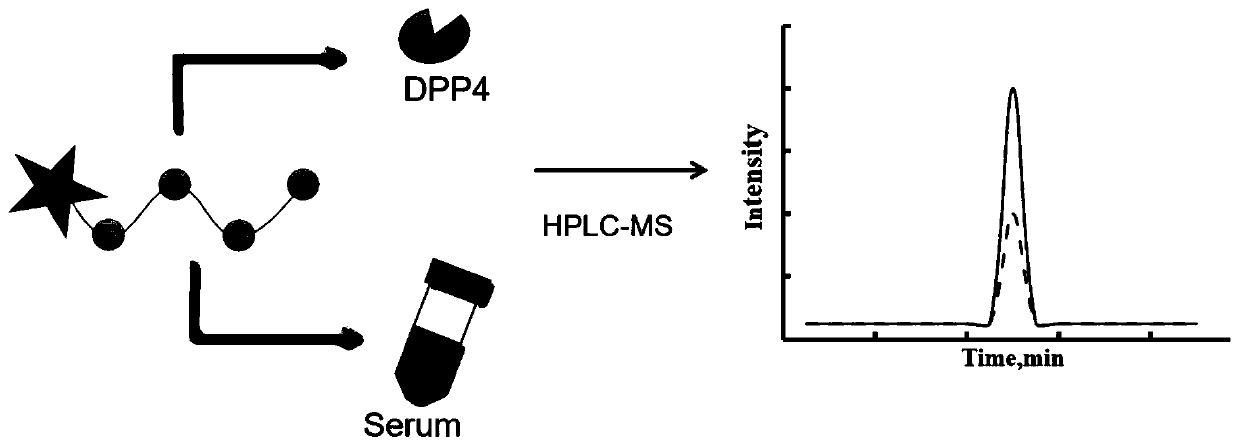Mass spectrum probe used for DPP-4 activity detection, and preparation method and application thereof
A DPP-4 and activity detection technology, applied in the field of mass spectrometry probes for DPP-4 activity detection and their preparation, can solve problems such as difficult DPP-4 activity, and achieve the effects of high mass spectrometry response and high mass spectrometry detection accuracy
- Summary
- Abstract
- Description
- Claims
- Application Information
AI Technical Summary
Problems solved by technology
Method used
Image
Examples
Embodiment 1
[0029] Embodiment 1: the synthesis of DPP-4 mass spectrometry probe
[0030] The synthesis method of the DPP-4 mass spectrometry probe of the present embodiment mainly comprises the following steps:
[0031] 1. Resin swelling
[0032] Weigh 0.6g of 2-Chlorotrityl Chloride Resin resin with a substitution degree of 0.4mmol / g, put the resin into a reaction tube, add dichloromethane (DCM) (15ml / g), and shake for 30min.
[0033] 2. Take the first amino acid
[0034] Filter off the solvent through a sand core, add a 3-fold molar excess of Fmoc-L-Lys(Boc)-OH amino acid, then add a 5-fold molar excess of N,N-diisopropylethylamine (DIEA), and finally add a small amount Dimethylformamide (DMF) was dissolved, shaken for 1 h, and finally washed 6 times alternately with DMF and DCM.
[0035] 3. Deprotection
[0036] Add 15ml 20% piperidine DMF solution (15ml / g), react for 5min, remove the solvent, add 15ml 20% piperidine DMF solution (15ml / g), react for 15min.
[0037] 4. Detection
...
Embodiment 2
[0053] Example 2: Chemical Characterization of DPP-4 Mass Spectrometry Probe
[0054] The DPP-4 mass spectrometer probe was synthesized by the method described in Example 1, and the purity of the probe was analyzed by HPLC. Analysis conditions are: Agilent 1260HPLC chromatographic system, equipped with variable wavelength detector (VWD), detection wavelength 214nm; chromatographic column, Agilent Zorbax SB-C 18 (4.6mm×100mm, 1.8μm); mobile phase is 0.05% formic acid-water (A) and 0.05% formic acid-acetonitrile (B); flow rate 0.4mL / min; gradient elution: 0-5min, 1%B; 5 -40min, 1-30%B; 40-45min, 30-100%B; 40-45min, 100%B; injection volume 10μL; column temperature 30°C.
[0055] After dissolving the DPP-4 mass spectrometry probe with pure water, centrifuge at 10000rpm for 10 minutes and then take the supernatant for sample analysis. The obtained HPLC chromatogram is as follows figure 2 shown.
[0056] Depend on figure 2 It can be seen that the DPP-4 mass spectrometry probe ...
Embodiment 3
[0059] Example 3: DPP-4 Mass Spectrometry Probe Detection Sensitivity of DPP-4
[0060] Take 5 μL mass spectrometry probe PP-DAPK (final concentration about 16 μM), different concentrations of DPP-4 (final concentrations are 500, 400, 250, 125, 50, 25, 10, 5, 2.5, 1.25, 0.5, 0.25, 0.05 μg / L), made up to 100 μL with 50 mM Tris-HCl pH 7.5, incubated at 37°C for 30 min, then added 200 μL methanol to stop the reaction, the solution was vortexed, centrifuged, and the supernatant was taken for injection analysis. The analysis conditions are: Agilent 1200HPLC chromatographic system, Api 4000 triple quadrupole mass in series (HPLC-QqQ-MS); ESI ion source; positive ion mode; MRM mode; source voltage, 4500V; source temperature 500 ° C; chromatographic column, Zorbax SB C18 (4.6mm×100mm, 1.8μm); the mobile phase is 0.05% formic acid-water (A) and 0.05% formic acid-acetonitrile (B); the flow rate is 0.4mL / min; the elution gradient is 0-1min, 1%B ;1-7min, 1-70%B; 7-7.5min, 70-99%B; 7.5-11...
PUM
 Login to View More
Login to View More Abstract
Description
Claims
Application Information
 Login to View More
Login to View More - R&D Engineer
- R&D Manager
- IP Professional
- Industry Leading Data Capabilities
- Powerful AI technology
- Patent DNA Extraction
Browse by: Latest US Patents, China's latest patents, Technical Efficacy Thesaurus, Application Domain, Technology Topic, Popular Technical Reports.
© 2024 PatSnap. All rights reserved.Legal|Privacy policy|Modern Slavery Act Transparency Statement|Sitemap|About US| Contact US: help@patsnap.com










